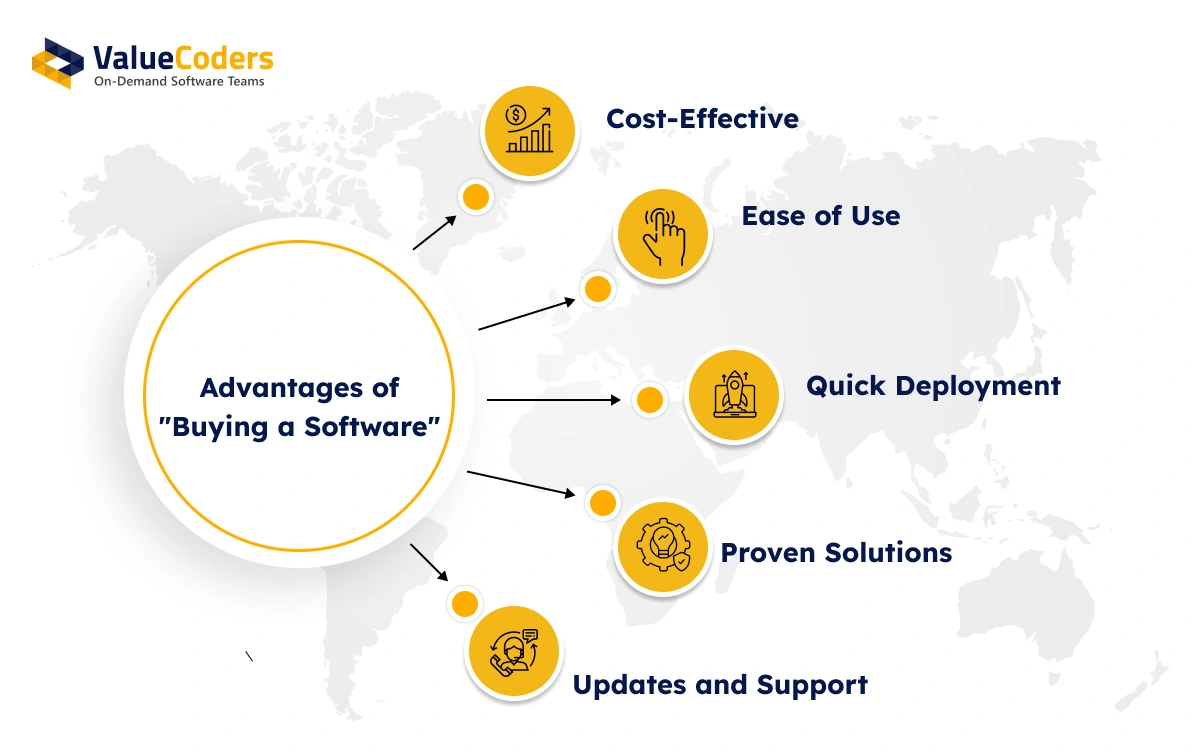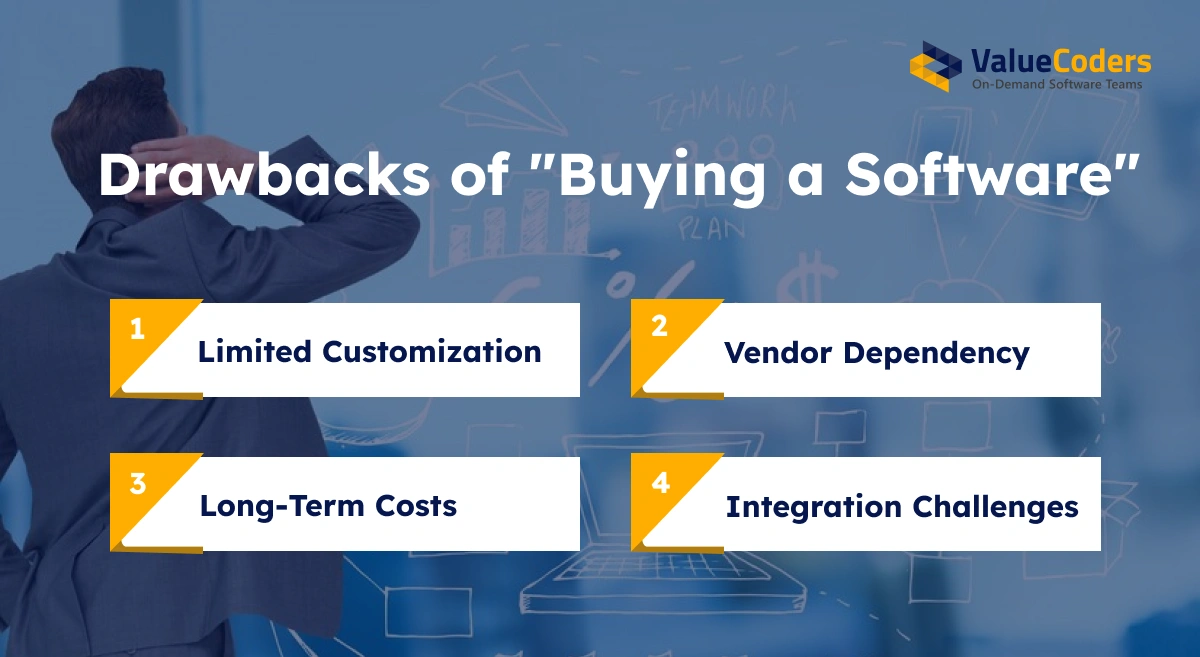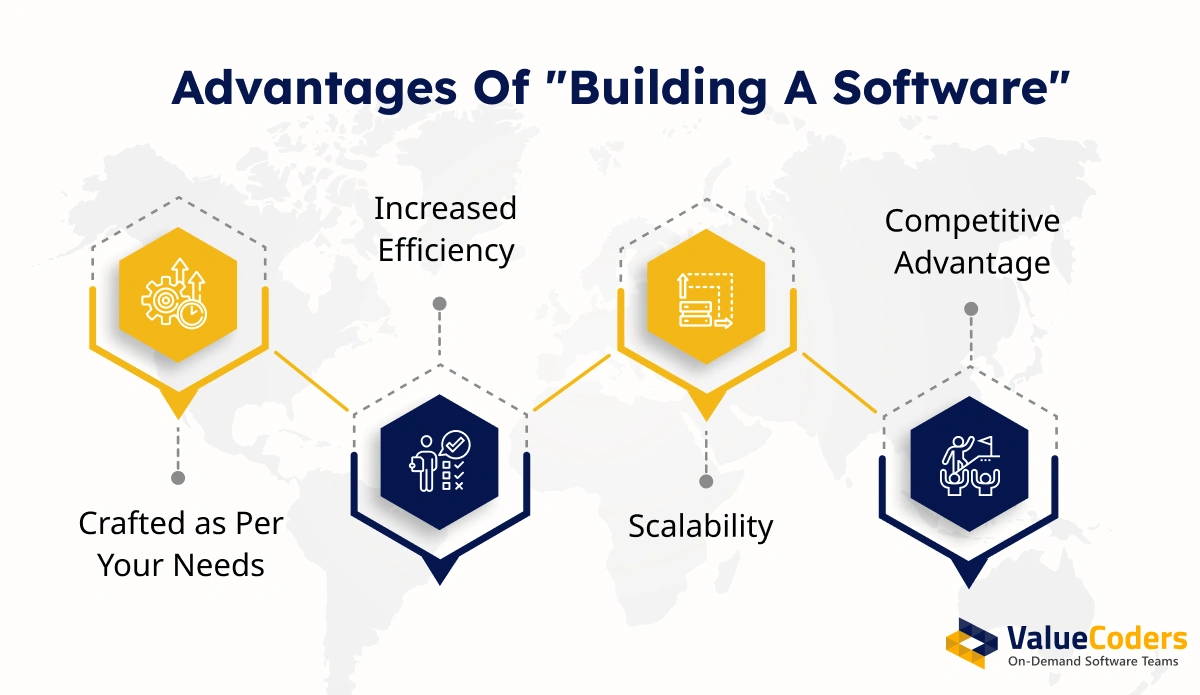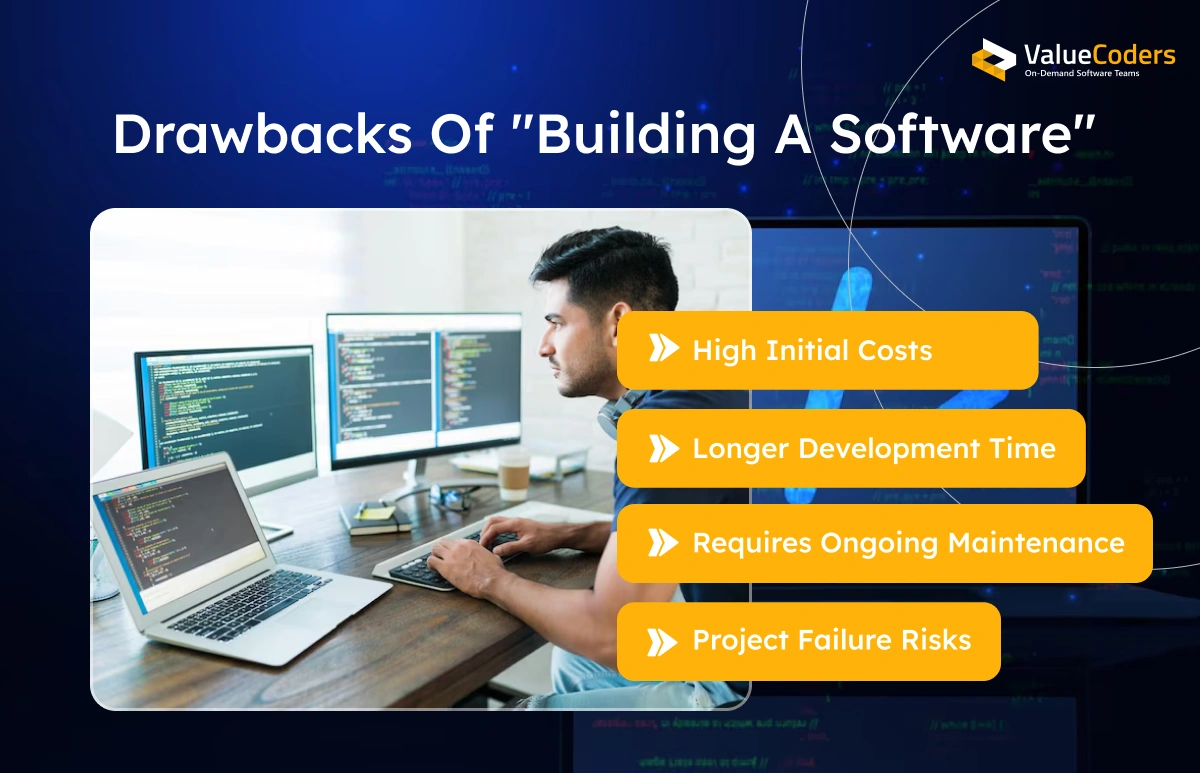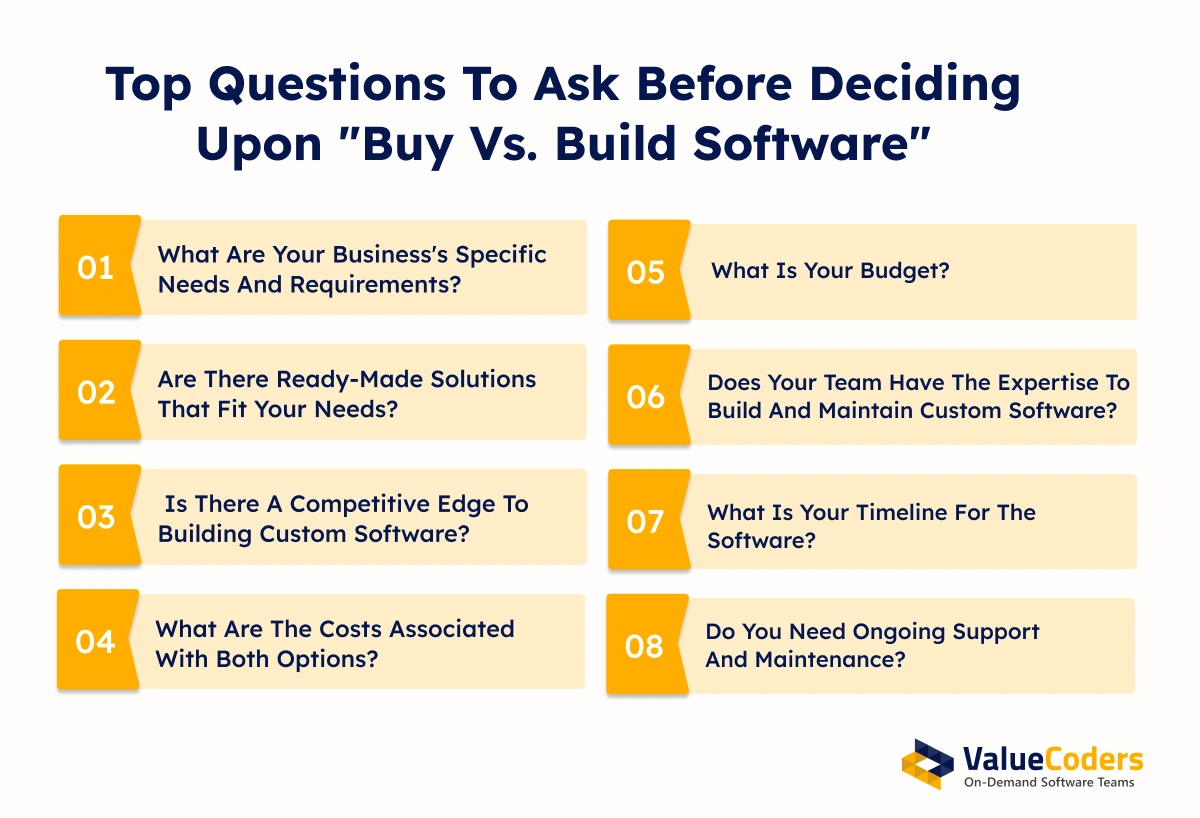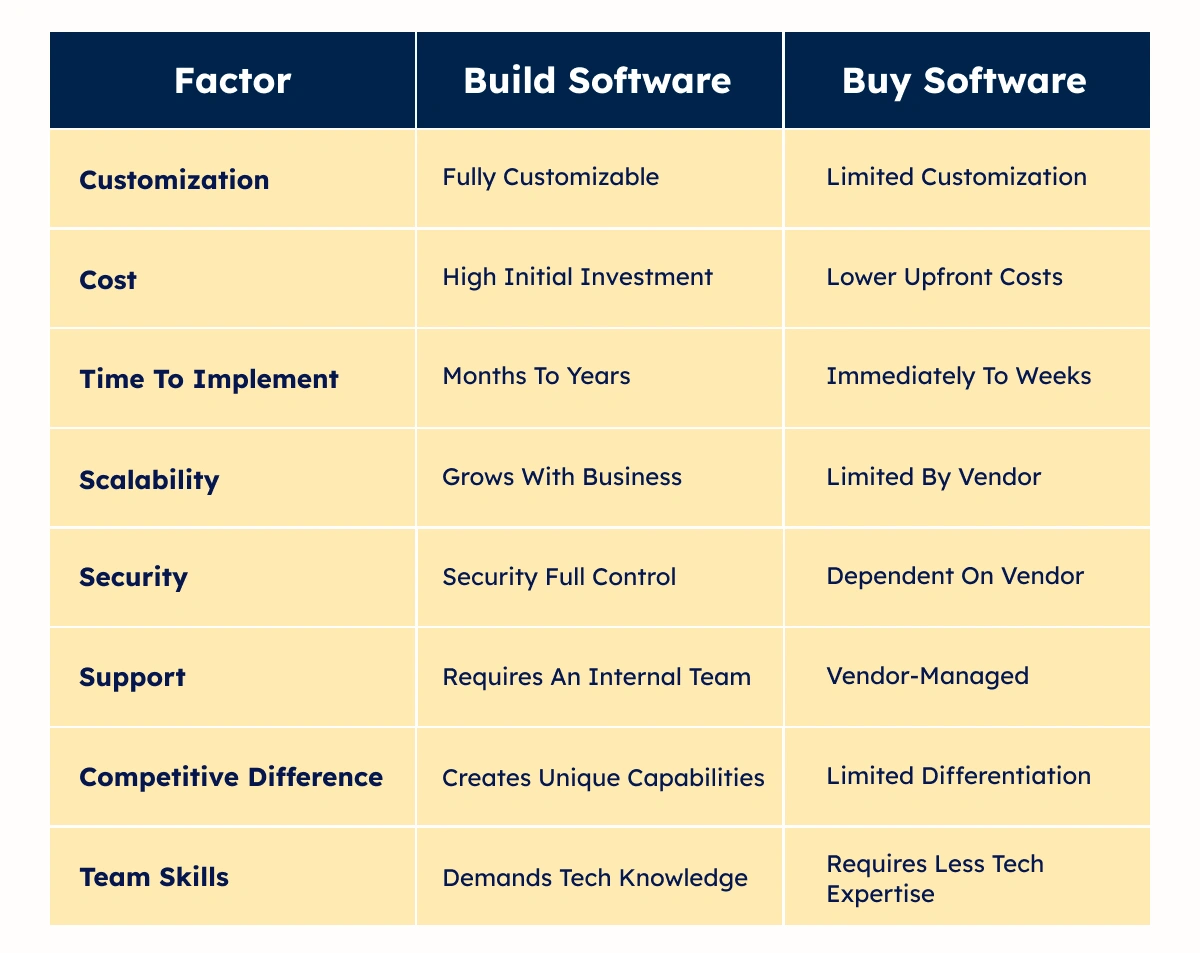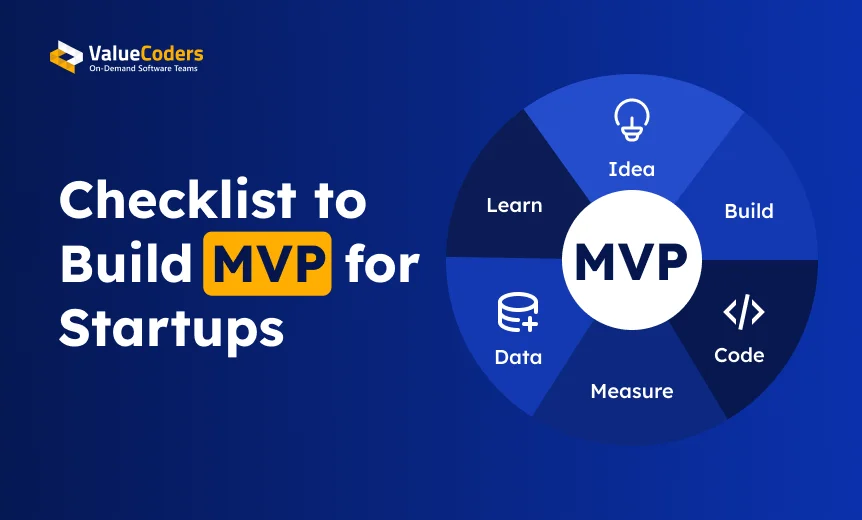Are you struggling with whether to buy or build software for your business?
As a tech lead or business owner, you often face a challenge when deciding whether to buy an existing software solution or invest in building a new custom software solution.
“Build vs buy software” is a digital strategy dilemma for all modern businesses.
Buying a software solution provides quick deployment and a proven track record. On the other hand, building a software allows to tailor it to your custom business needs. Your choice would directly impacts the costs, flexibility and success of your business. So, how do you decide then?
Explore our analysis for “build vs buy software” where we have examined both paths, their benefits and drawbacks. Thus, we will help you to choose the best fit for your business requirements.
Buy: Buying Off-the-Shelf Software
Many businesses choose an off-the-shelf software development strategy because it is readily available and requires little effort to set up. So, you don’t have to create something from the start. Just find a suitable software that meets your business needs and start using it the right way.
Companies offering software development solutions provide pre-built products that cater to common business needs.
Benefits of Buying Software
Cost-Effective
Ready-made software typically costs less upfront than building from scratch. You avoid paying developer salaries, project management costs, and the expenses of testing and deployment.
Small and mid-sized businesses find this especially attractive when working with limited budgets. The predictable monthly or annual fees make financial planning simpler.
- Cheaper upfront compared to a custom solution.
- It is an affordable choice.
Ease of Use
Commercial software products are designed with user experience in mind. They are built to be intuitive and accessible, even for team members without technical backgrounds.
Most suppliers offer complete documentation, training materials, and customer support to get your staff up and running in no time.
- Ready-made software solutions come with user-friendly interfaces and specific workflows.
- Businesses can start using the software with minimal training.
Quick Deployment
Pre-built solutions can be deployed within days or weeks, whereas custom development can take months or even years.
Whereas market conditions require a rapid response or you require responding to an urgent business requirement, software procurement provides you with the flexibility of instant deployment.
Your team can start using the solution almost immediately, without waiting through development cycles.
- Most offshore software development solutions are ready to use immediately.
- Suitable for companies that need a fast solution.
Proven Solutions
Established software solutions have been vetted by thousands of users from various industries. Major bugs have been discovered and resolved, and the software has been tested and proven to work in real-world environments.
This history minimizes risk and provides you with assurance that the solution will work as intended. You also benefit from the lessons learned from other companies’ experiences.
- Commercial software is tested and used by many businesses.
- Offers a track record of reliability and security.
Updates and Support
Software vendors handle all maintenance, updates, and security patches as part of your subscription. Their dedicated teams regularly watch for vulnerabilities and continuously enhance the product.
When problems arise, expert support teams are available to solve the complex issues. This eliminates the burden of consistent maintenance from the internal team, allowing them to focus on your core business activities.
- Software vendors provide frequent updates, security alerts, and customer support.
- Reduces the workload on internal IT staff.
With 250+ experts and 4200+ projects delivered, we build solutions aligned with your unique goals.
Cons of Buying Software
Limited Customization
Off-the-shelf solutions are built to cater to various customers in different industries. While they often include customization options, these have limits. Although they may come with customization, there are limitations.
You may have to change your processes to suit the software instead of having software that exactly suits your processes. For businesses that have specialized needs or unusual workflows, this limited flexibility can prove to be a serious limitation.
- Pre-built solutions may not meet all business requirements.
- Companies may need to adjust their workflows to fit the software.
Vendor Dependency
There is always a business risk associated with third-party software. Vendors can change prices, remove products from the line, or even go out of business in extreme cases. Your critical business processes become tied to decisions made by external companies.
This dependency can leave you scrambling if the vendor makes changes that negatively impact your operations.
- Businesses rely on the vendor for updates and support.
- If the vendor discontinues the software, companies may need to switch platforms.
Long-Term Costs
Subscription fees add up over time. What seems affordable initially might become a significant expense as your company grows and user counts increase.
Many software vendors charge per user, which can make costs unpredictable as your team expands. After several years, the total spent on subscriptions might exceed what custom development would have cost.
- Licensing fees, subscription costs, and additional user fees can add up over time.
- Some vendors charge extra for support, upgrades, or customization.
Integration Challenges
Getting new software to work with your existing systems can be complicated. While many commercial solutions offer APIs and integration capabilities, connecting with legacy systems or other specialized software can require significant effort.
These integration difficulties may lead to data silos or require manual processes to bridge gaps between systems.
Also read: Why Custom Software Development Saves Enterprises Millions In The Long Run
Build: Creating Custom Software
For businesses that require a tailored software solution, building software is an attractive option for them. Dedicated software development teams can create custom software applications that match a business’ exact needs and fulfill them.
Pros of Building a Software
Crafted as Per Your Needs
Custom software is created specifically for your business needs. Each feature exists for a reason, and the whole user interface can be optimized towards your team’s work processes and preferences.
This perfect fit means increased productivity and reduced workarounds. Your software can reflect your unique business processes, providing you exactly what you need without compromise.
- Custom software is built specifically for a company’s business model and processes.
- Allows for full control over features, design, and functionality.
Increased Efficiency
When software matches your exact processes, your team works more efficiently. Tasks that might require multiple steps in generic software can be streamlined into simpler workflows in custom solutions.
This efficiency translates directly to time saved, reduced errors, and improved employee satisfaction as they work with tools designed specifically for them.
- Helps automate and streamline business operations.
- Reduces reliance on third-party applications.
Scalability
Custom software can expand with your business. When your needs change, you can implement new features and capabilities without waiting for a vendor’s product roadmap to catch up to your needs.
This ability future-proofs your business and keeps your software investment working for you as market conditions and business objectives shift.
- Custom-built software can grow alongside your business.
- New features can be added over time without affecting performance.
Competitive Advantage
Proprietary software is a major competitive advantage. While your competitors have the same tools as everybody else, your bespoke solution can support distinctive offerings or better customer experiences.
This benefit is especially precious in sectors where technology is the core of service delivery or where minor efficiency improvements generate huge market benefits.
- Unlike off-the-shelf software, custom solutions can offer unique features.
- Can help improve business processes and provide better user experiences.
Also read: Custom Software Vs. Off-The-Shelf Solutions: What’s Best For Your Startup?
Cons of Building Software
High Initial Costs
Building software requires significant upfront capital. Startup product development services cost, developer salaries, project management, quality assurance, and other development costs add up quickly.
This high initial investment presents a financial hurdle for many businesses, particularly startups and small companies with limited cash reserves.
- Hiring developers, testers, and project managers increases costs.
- Companies must invest in infrastructure, security, and compliance.
Longer Development Time
Custom development takes time. From initial requirements gathering through design, development, testing, and deployment, the process typically spans months, sometimes years, for complex systems.
This extended timeline means a longer wait before you see returns on your business software investment and might mean missing short-term market opportunities.
- Software development can take months or years, depending on complexity.
- Requires careful planning and execution.
Requires Ongoing Maintenance
When you have it built, you have complete control over everything in your software, from maintenance to bug fixes and security patches. This necessitates technical staff on hand or ongoing relationships with development partners.
The responsibility for keeping the software running smoothly and securely falls entirely on your organization, creating an ongoing operational burden.
- Businesses must handle software updates, security patches, and bug fixes.
- Dedicated software development teams are needed to maintain and improve the software.
Project Failure Risks
Software development projects often run over budget, behind schedule, or without delivering promised functionality. With good management and skilled development partners, your project is under substantial risk.
They are scope creep, technical hurdles, or altered business needs that will sidetrack even well-designed projects.
- Software projects can fail due to poor planning or changing requirements.
- Businesses may overspend or experience delays.
We deliver 87% of projects ahead of schedule. Accelerate your software launch with confidence.
Questions to Ask Before Choosing Between Build vs Buy Software
Before going forward into the development, these critical questions will help clarify your organization’s true needs and constraints. This will help prevent costly missteps down the road.
1. What are your business’s specific needs and requirements?
- List must-have features and functionalities.
- Identify workflows that make your business unique.
- Determine which processes could provide competitive advantages if optimized.
2. Are there ready-made solutions that fit your needs?
- Research what’s available in the market.
- Evaluate how much customization each option would require.
- Check if industry-specific solutions exist for your sector.
3. Is there a competitive edge to building custom software?
- Consider how technology differentiates you from competitors.
- Evaluate if custom features could create unique customer experiences.
- Determine if proprietary processes could be protected through custom development.
4. What are the costs associated with both options?
- Calculate total cost of ownership over 3-5 years.
- Include licensing, implementation, training, and maintenance.
- Consider hidden costs like integration work and business disruption.
5. What is your budget?
- Determine your available capital for upfront investment.
- Evaluate your tolerance for ongoing operational expenses.
- Consider funding options if building requires capital you don’t have.
6. Does your team have the expertise to build and maintain custom software?
- Assess your internal technical capabilities.
- Evaluate the availability of qualified development partners.
- Consider the talent market for ongoing maintenance needs.
7. What is your timeline for the software?
- Determine how quickly you need a solution implemented.
- Consider market pressures and competitive factors.
- Evaluate if a phased approach could work for custom development.
8. Do you need ongoing support and maintenance?
- Consider your internal capacity for software maintenance.
- Evaluate the criticality of the software to your operations.
- Determine your tolerance for managing technical debt.
92% of our clients report higher efficiency after adopting our custom-built software solutions.
Build vs Buy: Key Differences
Also read: Custom Software Solutions: Tailoring Success For Every Business
Build vs Buy: Steps for Decision Making
Making this significant technology decision requires a methodical approach. Follow these proven steps to evaluate your options thoroughly and arrive at the choice that truly serves your long-term business goals.
Step 1: Perform Discovery Interviews
- Talk with end users about their daily tasks and pain points
- Interview department heads about business objectives and requirements
- Speak with IT staff about technical constraints and integration needs
- Document current workflows and identify improvement opportunities
Step 2: Define & Prioritize Requirements
- Create a comprehensive list of functional requirements
- Identify must-have vs. nice-to-have features
- Rank requirements based on business impact
- Establish clear success criteria for the software solution
Step 3: Evaluate Functional Areas Against Evaluation Criteria
- Create a scoring matrix for each major requirement
- Rate how well existing solutions meet each need
- Identify gaps between available solutions and requirements
- Consider the importance of each gap to business operations
Step 4: Look into Building Custom Software
- Get preliminary estimates from development partners
- Research technology stacks suitable for your needs
- Outline potential development approaches and timelines
- Evaluate your organization’s capacity to manage a development project
Step 5: Look into Buying Software
- Research available solutions in your industry
- Request demos from promising vendors
- Collect pricing information for licensing and implementation
- Ask about customization options and limitations
Step 6: Provide Build vs Buy Recommendation
- Compare costs over a 3-5 year period
- Evaluate how each option meets your critical requirements
- Consider timing and implementation impacts on your business
- Present findings to stakeholders with clear recommendations
Also read: Top 20+ Custom Software Development Companies In 2025
When Should You Buy Software?
- Sometimes the smartest technology move is leveraging existing solutions. Discover the scenarios where purchasing software delivers superior value and minimizes unnecessary business risk.
- You need a quick solution with minimal setup.
- Your requirements match existing software solutions.
- You lack an internal development team.
- Your budget is limited and can accommodate ongoing subscription fees.
When Should You Build Software?
- Creating custom software isn’t just for tech giants. These situations warrant investing in bespoke development that could become your company’s most valuable competitive advantage.
- Your business needs are unique and require custom features.
- You want full control over security, integrations, and updates.
- Your business will grow, and off-the-shelf solutions are too restrictive.
- You want to differentiate your business through custom software.
We’ve delivered customized solutions where off-the-shelf software failed—let’s create yours.
Final Words
Choosing between building and buying software is a critical decision for businesses. Buying software works for companies that require quick, cost-effective solutions. On the other hand, building software is ideal for those requiring customization and long-term flexibility.
The right software choice supports your growth, strengthens your market position, and helps your team work more effectively. Take time to thoroughly evaluate your options before committing to either approach.
For businesses unsure which route to take, consulting a leading software product development company like ValueCoders can help evaluate options and ensure the right choice.
Our software experts build innovative solutions for our global clients and help them scale fast in this competitive business era.

